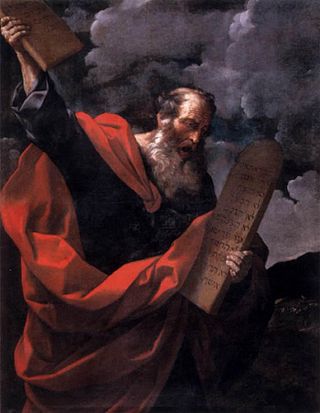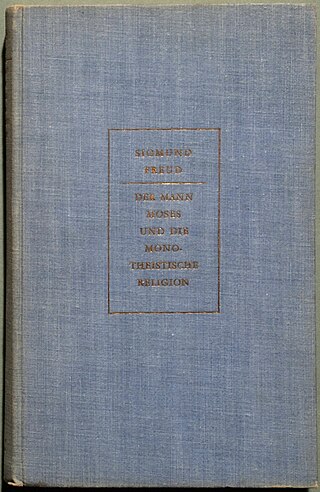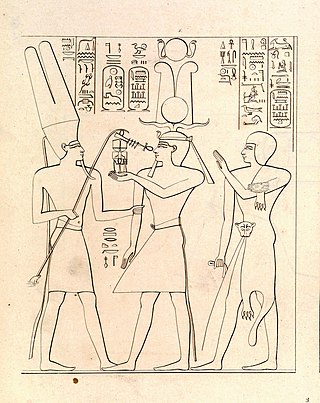Monotheism is the belief that one god is the only deity. A distinction may be made between exclusive monotheism, in which the one God is a singular existence, and both inclusive and pluriform monotheism, in which multiple gods or godly forms are recognized, but each are postulated as extensions of the same God.

Moses was a Hebrew prophet, teacher and leader, according to Abrahamic tradition. He is considered the most important prophet in Judaism and Samaritanism, and one of the most important prophets in Christianity, Islam, the Baháʼí Faith, and other Abrahamic religions. According to both the Bible and the Quran, Moses was the leader of the Israelites and lawgiver to whom the prophetic authorship of the Torah is attributed.

Akhenaten, also spelled Akhenaton or Echnaton, was an ancient Egyptian pharaoh reigning c. 1353–1336 or 1351–1334 BC, the tenth ruler of the Eighteenth Dynasty. Before the fifth year of his reign, he was known as Amenhotep IV.
Monolatry is the belief in the existence of many gods, but with the consistent worship of only one deity. The term monolatry was perhaps first used by Julius Wellhausen.

The Egyptian is a historical novel by Mika Waltari. It was first published in Finnish in 1945, and in an abridged English translation by Naomi Walford in 1949, from Swedish rather than Finnish. Regarded as "one of the greatest books in Finnish literary history", it is, so far, the only Finnish novel to be adapted into a Hollywood film, which happened in 1954.

The Great Hymn to the Aten is the longest of a number of hymn-poems written to the sun-disk deity Aten. Composed in the middle of the 14th century BC, it is varyingly attributed to the 18th Dynasty Pharaoh Akhenaten or his courtiers, depending on the version, who radically changed traditional forms of Egyptian religion by replacing them with Atenism. The hymn bears a notable resemblance to the biblical Psalm 104.

Atenism, also known as the Aten religion, the Amarna religion, and the Amarna heresy, was a religion in ancient Egypt. It was founded by Akhenaten, a pharaoh who ruled the New Kingdom under the Eighteenth Dynasty. The religion is described as monotheistic or monolatristic, although some Egyptologists argue that it was actually henotheistic. Atenism was centred on the cult of Aten, a god depicted as the disc of the Sun. Aten was originally an aspect of Ra, Egypt's traditional solar deity, though he was later asserted by Akhenaten as being the superior of all deities. In the 14th century BC, Atenism was Egypt's state religion for around 20 years, and Akhenaten met the worship of other gods with persecution; he closed many traditional temples, instead commissioning the construction of Atenist temples, and also suppressed religious traditionalists. However, subsequent pharaohs toppled the movement in the aftermath of Akhenaten's death, thereby restoring Egyptian civilization's traditional polytheistic religion. Large-scale efforts were then undertaken to remove from Egypt and Egyptian records any presence or mention of Akhenaten, Atenist temples, and assertions of a uniquely supreme god.
Judith Tarr is an American fantasy and science fiction author.
The Amarna Period was an era of Egyptian history during the later half of the Eighteenth Dynasty when the royal residence of the pharaoh and his queen shifted from the old capital of Thebes (Waset) to Akhetaten in what is now modern Amarna. This move occurred during the reign of Amenhotep IV, who changed his name to Akhenaten in order to reflect the dramatic change of Egypt's polytheistic religion into one where the sun disc Aten was worshipped over all other gods. Toward the end of a Akhenaten's reign, he had a mysterious co-regent, Smenkhkare, about which very little is known; similarly, Neferneferuaten, a female ruler also exercised influence.
Osarseph or Osarsiph is a legendary figure of Ancient Egypt who has been equated with Moses. His story was recounted by the Ptolemaic Egyptian historian Manetho in his Aegyptiaca ; Manetho's work is lost, but the 1st century AD Jewish historian Josephus quotes extensively from it.

Joseph and His Brothers is a four-part novel by Thomas Mann, written over the course of 16 years. Mann retells the familiar stories of Genesis, from Jacob to Joseph, setting it in the historical context of the Amarna Period. Mann considered it his greatest work.
Richard Elliott Friedman is an American biblical scholar, theologian, and translator who currently serves as the Ann and Jay Davis Professor of Jewish Studies at the University of Georgia.

Moses and Monotheism is a 1939 book about the origins of monotheism written by Sigmund Freud, the founder of psychoanalysis. It is Freud's final original work and it was completed in the summer of 1939 when Freud was, effectively speaking, already "writing from his death-bed." It appeared in English translation the same year.
Zannanza was a Hittite prince, son of Suppiluliuma I, king of the Hittites. He is best known for almost becoming the pharaoh of Egypt, and because his death caused a diplomatic incident between the Hittite and Egyptian empires, resulting in warfare.
Ahmed Osman is an Egyptian-born author. He has put forward a number of theories, some revisionist in nature, about Ancient Egypt and the origins of Islam, Judaism and Christianity.

The Bible makes reference to various pharaohs of Egypt. These include unnamed pharaohs in events described in the Torah, as well as several later named pharaohs, some of whom were historical or can be identified with historical pharaohs.
Sigmund Freud's views on religion are described in several of his books and essays. Freud considered God as a fantasy, based on the infantile need for a dominant father figure, with religion as a necessity in the development of early civilization to help restrain our violent impulses, that can now be discarded in favor of science and reason.

Johann Christoph "Jan" Assmann was a German Egyptologist, cultural historian, and religion scholar.

A God Against the Gods is a 1976 historical novel by political novelist Allen Drury, which chronicles ancient Egyptian Pharaoh Akhenaten's attempt to establish a new religion in Egypt. It is told in a series of monologues by the various characters.
The Exodus is the founding myth of the Israelites. The scholarly consensus is that the Exodus, as described in the Torah, is not historical, even though there may be a historical core behind the Biblical narrative.









